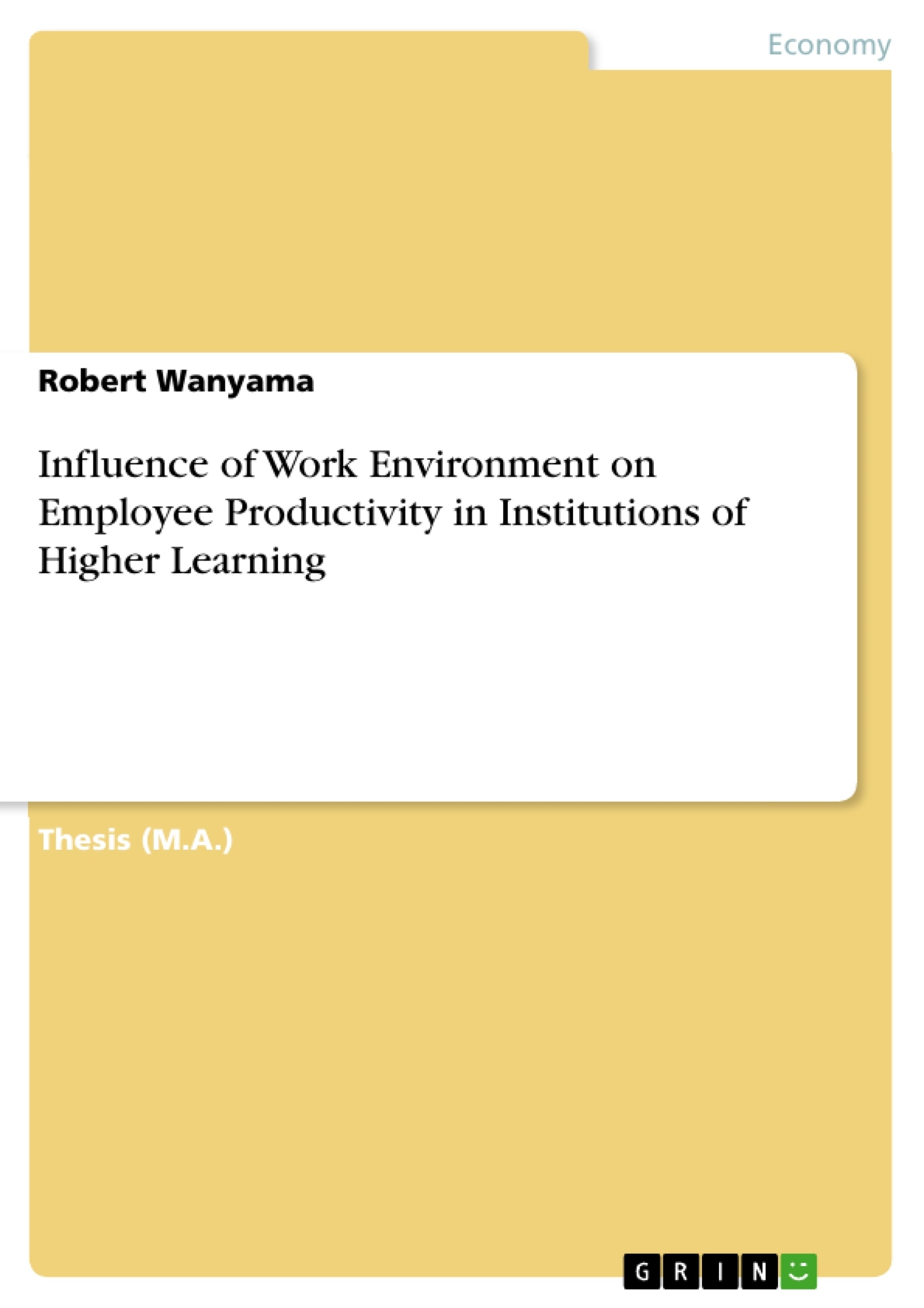The purpose of the study was to investigate the influence of the work environment on the productivity of staff. The study was guided by the specific objectives; to identify influence of physical work environment on productivity among teaching and non-teaching employees; to find out the influence of reward systems on employee productivity and to what extent does performance feedback influence employee productivity. The study undertook a literature review on Social Exchange Theory and Person- Environment Fit Theory as the theoretical framework. The conceptual framework was focused on Physical Environment, Reward systems and performance-based pay driven by the study’s objectives. The study used both qualitative and quantitative methods to collect data which include questionnaires and key informant interviews. The study did a pilot study to familiarize with the area of study. The study used self - administration process of distribution as this assisted in providing clarity and completeness of the instrument from the respondents. Data gathered was analyzed using the Statistical Package for Social Sciences (SPSS) software version 20.0.
Inhaltsverzeichnis (Table of Contents)
- CHAPTER ONE
- INTRODUCTION
- 1.1 Background to the Study
- 1.2 Problem Statement
- 1.3 Purpose of the Study
- 1.4 Research Objectives
- 1.5 Research Questions
- 1.6 Significance of the Study
- 1.7 Scope of the Study
- 1.8 Limitations of the Study
- 1.9 Definition of Terms
- CHAPTER TWO
- LITERATURE REVIEW
- 2.1 Introduction
- 2.2 Conceptual Framework
- 2.3 Theoretical Framework
- 2.4 Empirical Review
- 2.5 Summary of Literature Review
- CHAPTER THREE
- RESEARCH METHODOLOGY
- 3.1 Introduction
- 3.2 Research Design
- 3.3 Target Population
- 3.4 Sampling Technique
- 3.5 Sample Size
- 3.6 Data Collection Methods
- 3.7 Data Analysis Methods
- 3.8 Ethical Considerations
- CHAPTER FOUR
- DATA PRESENTATION, ANALYSIS AND INTERPRETATION
- 4.1 Introduction
- 4.2 Demographic Data
- 4.3 Influence of Physical Work Environment on Staff Productivity
- 4.4 Influence of Reward Systems on Staff Productivity
- 4.5 Influence of Performance Feedback on Staff Productivity
- CHAPTER FIVE
- SUMMARY OF FINDINGS, CONCLUSIONS AND RECOMMENDATIONS
- 5.1 Introduction
- 5.2 Summary of Findings
- 5.3 Discussion of Findings
- 5.4 Conclusion
- 5.5 Recommendations
Zielsetzung und Themenschwerpunkte (Objectives and Key Themes)
This research aims to explore the relationship between work environment factors and employee productivity in institutions of higher learning. Specifically, it investigates the influence of physical work environment, reward systems, and performance feedback on staff productivity. The study utilizes a mixed-methods approach to collect and analyze data from both teaching and non-teaching staff.
- The impact of physical work environment on staff productivity
- The role of reward systems in influencing employee motivation and productivity
- The effectiveness of performance feedback in enhancing employee performance
- The application of social exchange theory and person-environment fit theory to understand employee behavior and productivity in the workplace
- The challenges faced by institutions of higher learning in fostering a conducive work environment that promotes employee productivity
Zusammenfassung der Kapitel (Chapter Summaries)
- Chapter 1: Introduction: This chapter provides a background to the study, highlighting the contemporary workplace challenges and the importance of work environment on employee productivity. It outlines the problem statement, the research objectives and questions, the significance of the study, and the scope and limitations of the study.
- Chapter 2: Literature Review: This chapter delves into the theoretical and empirical framework of the study, exploring the existing knowledge on work environment, employee productivity, and the application of relevant theories like Social Exchange Theory and Person-Environment Fit Theory. It presents a comprehensive review of previous research findings and their implications for the study.
- Chapter 3: Research Methodology: This chapter outlines the research design, target population, sampling technique, data collection methods, data analysis techniques, and ethical considerations of the study. It provides a detailed description of the methodological approach employed in the research.
- Chapter 4: Data Presentation, Analysis and Interpretation: This chapter presents the collected data, analyzes the findings from the study, and interprets the results. It examines the relationship between physical work environment, reward systems, performance feedback, and employee productivity.
Schlüsselwörter (Keywords)
The primary focus of this research lies on understanding the influence of work environment on employee productivity in institutions of higher learning. Key terms include: work environment, employee productivity, physical work environment, reward systems, performance feedback, social exchange theory, person-environment fit theory, institutions of higher learning, Kenya.
- Citation du texte
- Robert Wanyama (Auteur), 2023, Influence of Work Environment on Employee Productivity in Institutions of Higher Learning, Munich, GRIN Verlag, https://www.grin.com/document/1357073



